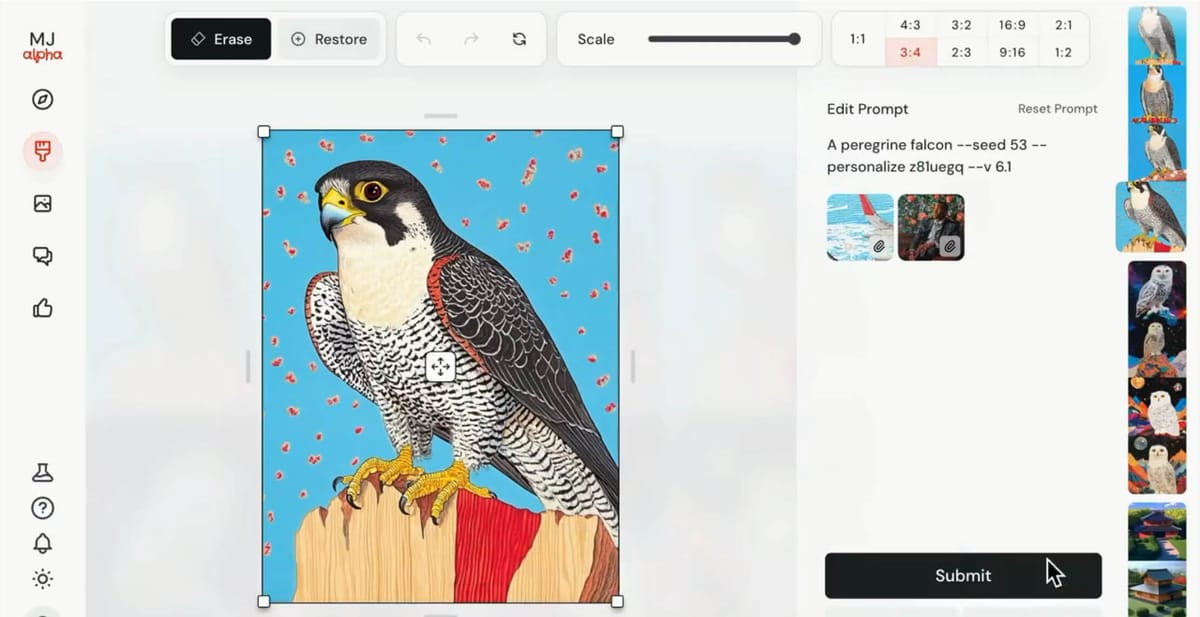
Midjourney, the popular AI image generation platform, has launched a new web editor, consolidating several key image manipulation tools into a single interface. The new editor consolidates a bunch of features (reframing, repainting, region variation, panning, and zooming) that previously required switching between different tools or relying on text commands.
For creators, this unified interface offers a smoother and more cohesive experience when generating and refining images. The shift signals Midjourney’s continued move away from its Discord roots toward a more robust web-based platform. Now, any user who has created at least ten images can access the new editor and begin creating directly on the Midjourney website.
Alongside the web editor, Midjourney announced the integration of message mirroring between its Web Rooms and Discord channels. Conversations in channels like “daily-theme,” “prompt-craft,” and “general-1” will now sync across both platforms, ensuring continuity in collaborations, regardless of where users engage.
This evolution from a Discord-based bot to a full-featured web platform has been in progress for the past six months. By making its tools more accessible through the web, Midjourney aims to eliminate the limitations that the Discord interface imposed on designers. This shift aligns with the company’s broader goal of enhancing usability and catering to the needs of visual creators.
The web editor also addresses one of the platform’s major criticisms: the Discord bot, while functional, lacked the interactive environment that designers often require. In contrast, competitors like Adobe Firefly launched as native web apps with seamless integration into design tools like Photoshop and Illustrator. Midjourney’s new editor is an attempt to bridge that gap and offer a more design-friendly experience.
Midjourney just released their web editor!!
— Nick St. Pierre (@nickfloats) August 16, 2024
It's actually one of the coolest features they've dropped in a while
essentially lets you do inpainting, panning, zooming and more all in a single step
really really powerful pic.twitter.com/Wgyi9ElE5N
Today’s announcement follows the recent release of Midjourney version 6.1, which brought substantial improvements to the platform. These included more coherent images—particularly in rendering hands, faces, and bodies—enhanced image quality, faster processing times, and improved text accuracy in image prompts. The update also introduced new personalization features, allowing users to reuse customization data from previous jobs.
These updates come at a time when the generative image space is becoming increasingly competitive. Midjourney faces growing pressure from emerging models like Flux 1 from Black Forest Lab. Paired with Realism LoRA, Flux 1 has quickly gained traction for its capability and, crucially, its accessibility as a free tool. It has already been integrated into major platforms like xAI’s Grok 2 and Freepik. Meanwhile, Google has entered the arena with the launch of Imagen 3, further intensifying competition.
Midjourney faces growing pressure from other players, such as the hot new open-source model Flux 1 from Black Forest Lab. Paired with Realism LoRA, Flux 1 has gained a strong following, praised for its capability and, importantly, its accessibility as a free tool. The model has already been integrated into leading platforms such as xAI’s Grok 2 and Freepik, further amplifying its reach.
Midjourney’s transition to a fully independent web app will likely be welcomed by many users who have long sought a more intuitive, design-focused experience. More importantly, this move better positions the company to expand its addressable market, attracting a broader range of creators who may have been hesitant or not allowed to use the platform’s Discord-based workflow.

